|
The Epipactis genus does seem prone to prducing some freaks. This one is at Brymbo Pool. Perhaps another year I may see just how it develops. I suspect it is different to those abnormals at Nant-y-Ffith
|
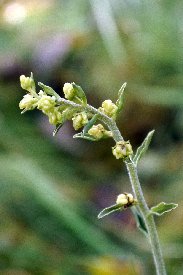
|
|
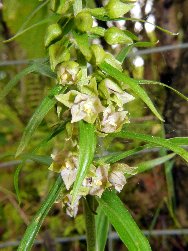
|
At Minera Lead Mines these is a small patch of Broad-leaved Helleborines where the flowers have a tendency for upside-downiness - resupination.
|
|
In the same area there is a probably related plant that is not only resupinate but also fasciated - all the flowers are condensed into a single mass. The flowers also seem to washed out of colour, rather than merely pale.
|
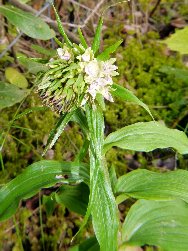
|
|

|
An unusual Southern Marsh Orchid found at Neston Old Key. Not quite sure exactly what has gone awry here.
|
|
It seems that Violet Helleborines are prone to having one or two mis-formed flowers on a spike. These two, from the same site and including a var. rosea, have missing or vestigial reproductive parts, have just four or five perianth segments. Similar plants have been reported from Somerset. One suggestion as to cause was the considerable age that individual plants can live. Genetic abnormalities can accumulate over time, or chromo-some fragility increase.
Epipactis species seem to be prone to mutations affecting flower structure with other examples on this page, each with their own version of flower deformity.
|
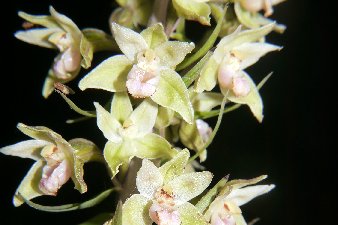 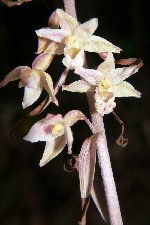
|
|
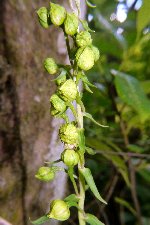 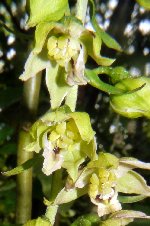
|
This Broad-leaved Helleborine's flowers are all round blobs and there seems to be no ovary. Two more examples nearby with open flowers. These seem to have 6-8 columns. grossly distorted, and the subsequent internal structures cause the flowers to be 70% larger than normal. This could be due to mutations of the MADS gene box, which controls the dev-opment of flower structure.
Seen first in 2017, they were still ging in 2019 suggesting a genetic abnormality rather than perhaps a virus induced abnormality.
|
|
Variegated leaves are a common feature of many strains of ornamental plants. Orchid seekers will occasionally find a plant with chloro-phyll-less patches on the leaves. This Green-flowered Helleborine was found in Alyn Waters Country Park in 2016.
Another example, but with green and purple variegation on Violet Hell-eborines was found at Severn Valley Country Park/
|
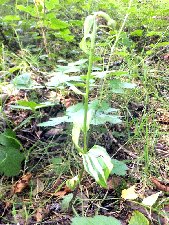 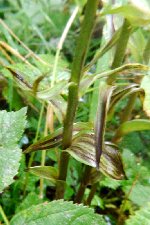
|
|
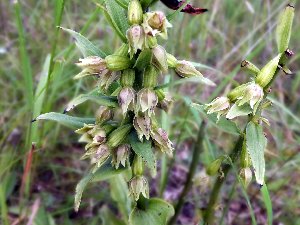
|
While there is no floral defects in this plant, the individual flowers are all crowded onto a short, stunted stem. In fact there seems to be double the number of flowers that are normally found on Green-flowered Helleborines. Again this was found in Alyn Waters Country Park. Less extreme examples have been seem of Dune Helleborines.
|
|
Pyramidal Orchid flowers are upside down when the flower is in bud, but as it opens the flower rotates into its correct alignment. When that fails it is termed a resupinate form. This example was found on Lindisfarne in 2014. A second example was found at Eryrys
|

|
|
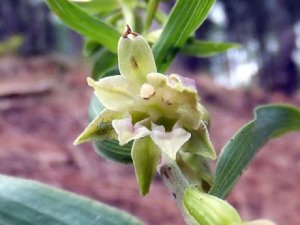
|
A truly bizarre flower! Two lips, two columns, normal petals and I think five sepals, the extra one lying below the lip. The other flowers on the stem were normal, thus the defect occurred during the development of this one flower. Ainsdale 2015.
|
|
Seen at Eryrys in 2016 this is a rather odd Common Spotted Orchid; a minimalist version. This has been viewed as a peloric form - where vertical symmetry has been swapped for radial symmetry. Personally I think each flower is missing a fully formed lip. The defect appears to affect all flowers on the spike.
|
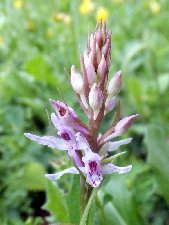
|
|
Another Common Spotted Orchid, this time eith many of the lower flowers without proper lip or spur. Oddly the flowers higher up are all normal. This site no longer exists so no way to check if the aberration continues.
|
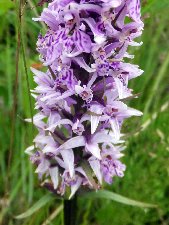
|
|
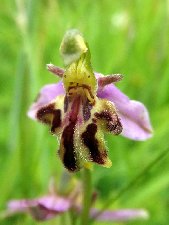
|
Bee Orchids are noted for their variant forms, but this isn't one. In one small clump there were a number of flowers with a range of deformed lips. This is perhaps the worst affected. Note the lack of dorsal sepal. Alyn Waters 2016. That this site is a former household waste site may be irrelevant or pertinent.
|
|
Another resupinate plant, this time an Early Purple Orchid found at Cors Goch in 2017. Looking at other examples of the species at the site it did not seem that the emergent flowers needed rotating to an upright orientation. Perhaps it happens before the individual flowers twist well before opening.
|

|
|
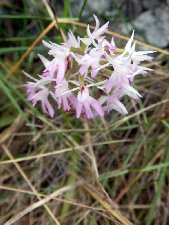
|
One from abroad; Mandrago reserve in Mallorca to be precise. I am reliably informed that Pyramidal Orchids from here often look like this, but I saw regular forms there and this just looks so atypical I cannot believe it hasn't got a variety name. Deserves to be in my freak show.
|
|
This Bee Orchid at Conwy is missing its lip. Could be pest damage, but there is no trace of any left overs, the column seems unformed and the sepals haven't bent back. I put down to developmental deformity.
|
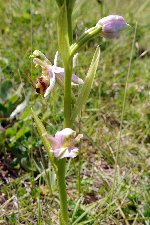
|
|
|
|






















